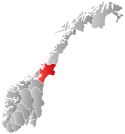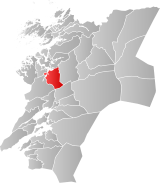Klinga Municipality
Klinga Municipality
Klinga herred | |
|---|---|
| Klingen herred (historic name) | |
 Nord-Trøndelag within Norway | |
 Klinga within Nord-Trøndelag | |
| Coordinates: 64°24′35″N 11°28′56″E / 64.40972°N 11.48222°E | |
| Country | Norway |
| County | Nord-Trøndelag |
| District | Namdalen |
| Established | 1 Jan 1891 |
| • Preceded by | Vemundvik Municipality |
| Disestablished | 1 Jan 1964 |
| • Succeeded by | Namsos Municipality |
| Administrative centre | Bangsund |
| Government | |
| • Mayor (1962–1963) | Alf Derås (Ap) |
| Area (upon dissolution) | |
• Total | 352 km2 (136 sq mi) |
| • Rank | #252 in Norway |
| Highest elevation | 680.5 m (2,232.6 ft) |
| Population (1963) | |
• Total | 2,466 |
| • Rank | #370 in Norway |
| • Density | 7/km2 (20/sq mi) |
| • Change (10 years) | |
| Demonym | Klingbygg[2] |
| Official language | |
| • Norwegian form | Neutral[3] |
| Time zone | UTC+01:00 (CET) |
| • Summer (DST) | UTC+02:00 (CEST) |
| ISO 3166 code | NO-1746[5] |
Klinga is a former municipality in the old Nord-Trøndelag county, Norway. The 352-square-kilometre (136 sq mi) municipality existed from 1891 until its dissolution in 1964. The municipality encompassed the mainland areas south of the river Namsen in what is now Namsos Municipality in Trøndelag county. The administrative centre was the village of Bangsund. Other villages in Klinga included Spillum and Klinga where Klinga Church is located.[6]
Prior to its dissolution in 1963, the 352-square-kilometre (136 sq mi) municipality was the 252nd largest by area out of the 689 municipalities in Norway. Klinga Municipality was the 370th most populous municipality in Norway with a population of about 2,466. The municipality's population density was 7 inhabitants per square kilometre (18/sq mi) and its population had increased by 6.1% over the previous 10-year period.[7][8]
General information
[edit]
The municipality of Klingen was established on 1 January 1891 when the municipality of Namsos herred was divided in two. The northern part became Vemundvik Municipality (population: 1,387) and the southern part became Klingen Municipality (population: 1,387). In 1917, the spelling of the name was changed to Klinga Municipality.[9]
During the 1960s, there were many municipal mergers across Norway due to the work of the Schei Committee. On 1 January 1964, a large municipal merger took place with the following areas being merged into a new, larger Namsos Municipality with 10,875 residents.[9]
- all of the town of Namsos (population: 5,224)
- all of Klinga Municipality (population: 2,482)
- all of Vemundvik Municipality (population: 2,040)
- the parts of Otterøy Municipality located north of the Namsenfjorden (population: 1,013)
- the Finnangerodden area on the island of Otterøya in Fosnes Municipality (population: 116)
Name
[edit]The municipality (originally the parish) is named after the old Klingen farm. The name is a form of the Old Norse word kringla which means "circle" or "orb". This name likely refers to the round-shaped mountain located behind the farm site.[10] Historically, the name of the municipality was spelled Klingen. On 3 November 1917, a royal resolution changed the spelling of the name of the municipality to Klinga.[11]
Churches
[edit]The Church of Norway had one parish (sokn) within Klinga Municipality. At the time of the municipal dissolution, it was part of the Namsos prestegjeld and the Indre Namdal prosti (deanery) in the Diocese of Nidaros.[8]
| Parish (sokn) | Church name | Location of the church | Year built |
|---|---|---|---|
| Klinga | Klinga Church | Klinga | 1866 |
Geography
[edit]The highest point in the municipality was the 680.5-metre (2,233 ft) tall mountain Hemnafjellet on the border with Otterøy Municipality.[1] The municipality is located at the inner end of the Namsenfjorden. Namdalseid Municipality was located to the west, Otterøy Municipality was located to the northwest, the town of Namsos and Vemundvik Municipality were both located to the north, Overhalla Municipality was located to the east, and Kvam Municipality was located to the south.
Government
[edit]While it existed, Klinga Municipality was responsible for primary education (through 10th grade), outpatient health services, senior citizen services, welfare and other social services, zoning, economic development, and municipal roads and utilities. The municipality was governed by a municipal council of directly elected representatives. The mayor was indirectly elected by a vote of the municipal council.[12] The municipality was under the jurisdiction of the Frostating Court of Appeal.
Municipal council
[edit]The municipal council (Herredsstyre) of Klinga was made up of 15 representatives that were elected to four year terms. The tables below show the historical composition of the council by political party.
| Party name (in Norwegian) | Number of representatives | |
|---|---|---|
| Labour Party (Arbeiderpartiet) | 10 | |
| Communist Party (Kommunistiske Parti) | 1 | |
| Christian Democratic Party (Kristelig Folkeparti) | 1 | |
| Centre Party (Senterpartiet) | 1 | |
| Joint List(s) of Non-Socialist Parties (Borgerlige Felleslister) | 2 | |
| Total number of members: | 15 | |
| Note: On 1 January 1964, Klinga Municipality became part of Namsos Municipality. | ||
| Party name (in Norwegian) | Number of representatives | |
|---|---|---|
| Labour Party (Arbeiderpartiet) | 9 | |
| Communist Party (Kommunistiske Parti) | 1 | |
| Christian Democratic Party (Kristelig Folkeparti) | 1 | |
| List of workers, fishermen, and small farmholders (Arbeidere, fiskere, småbrukere liste) | 1 | |
| Joint List(s) of Non-Socialist Parties (Borgerlige Felleslister) | 3 | |
| Total number of members: | 15 | |
| Party name (in Norwegian) | Number of representatives | |
|---|---|---|
| Labour Party (Arbeiderpartiet) | 6 | |
| Communist Party (Kommunistiske Parti) | 1 | |
| Christian Democratic Party (Kristelig Folkeparti) | 1 | |
| List of workers, fishermen, and small farmholders (Arbeidere, fiskere, småbrukere liste) | 2 | |
| Local List(s) (Lokale lister) | 2 | |
| Total number of members: | 12 | |
| Party name (in Norwegian) | Number of representatives | |
|---|---|---|
| Labour Party (Arbeiderpartiet) | 6 | |
| Communist Party (Kommunistiske Parti) | 2 | |
| Christian Democratic Party (Kristelig Folkeparti) | 1 | |
| Joint List(s) of Non-Socialist Parties (Borgerlige Felleslister) | 3 | |
| Total number of members: | 12 | |
| Party name (in Norwegian) | Number of representatives | |
|---|---|---|
| Labour Party (Arbeiderpartiet) | 7 | |
| Communist Party (Kommunistiske Parti) | 2 | |
| Joint List(s) of Non-Socialist Parties (Borgerlige Felleslister) | 3 | |
| Total number of members: | 12 | |
| Party name (in Norwegian) | Number of representatives | |
|---|---|---|
| Labour Party (Arbeiderpartiet) | 8 | |
| Joint List(s) of Non-Socialist Parties (Borgerlige Felleslister) | 4 | |
| Total number of members: | 12 | |
| Note: Due to the German occupation of Norway during World War II, no elections were held for new municipal councils until after the war ended in 1945. | ||
Mayors
[edit]The mayor (Norwegian: ordfører) of Klinga was the political leader of the municipality and the chairperson of the municipal council. Here is a list of people who held this position:[19]
- 1891–1907: Halvdan Romstad (V)
- 1908–1913: Eirik Spillum (LL)
- 1914–1916: Karl Klingen (Rp)
- 1917–1922: Ole Schiefloe (LL)
- 1923–1925: Nils Christian Pehrson (Ap)
- 1926–1939: Martin Tørring (Ap)
- 1940–1954: Konrad Aagesen (Ap)
- 1955-1955: Arne Kvam (Ap)
- 1956–1961: Sverre Lindseth (Ap)
- 1962–1963: Alf Derås (Ap)
See also
[edit]References
[edit]- ^ a b "Kart over Norge" (in Norwegian). Kartverket. 16 January 2024.
- ^ "Navn på steder og personer: Innbyggjarnamn" (in Norwegian). Språkrådet.
- ^ "Norsk Lovtidende. 2den Afdeling. 1932. Samling af Love, Resolutioner m.m". Norsk Lovtidend (in Norwegian). Oslo, Norway: Grøndahl og Søns Boktrykkeri: 453–471. 1932.
- ^ "Forskrift om målvedtak i kommunar og fylkeskommunar" (in Norwegian). Lovdata.no.
- ^ Bolstad, Erik; Thorsnæs, Geir, eds. (26 January 2023). "Kommunenummer". Store norske leksikon (in Norwegian). Kunnskapsforlaget.
- ^ Rosvold, Knut A., ed. (19 April 2018). "Bangsund". Store norske leksikon (in Norwegian). Kunnskapsforlaget. Retrieved 21 April 2018.
- ^ Statistisk sentralbyrå. "Table: 06913: Population 1 January and population changes during the calendar year (M)" (in Norwegian).
- ^ a b Statistisk sentralbyrå (1 January 1951). Norges Sivile, Geistlige, Rettslige og Militære Inndeling 1. Januar 1951 (PDF). Norges Offisielle Statistikk (in Norwegian). Oslo, Norge: H. Aschehoug & Co.
- ^ a b Jukvam, Dag (1999). "Historisk oversikt over endringer i kommune- og fylkesinndelingen" (PDF) (in Norwegian). Statistisk sentralbyrå.
- ^ Rygh, Oluf (1903). Norske gaardnavne: Nordre Trondhjems amt (in Norwegian) (15 ed.). Kristiania, Norge: W. C. Fabritius & sønners bogtrikkeri. p. 327.
- ^ "Norsk Lovtidende. 2den Afdeling. 1917. Samling af Love, Resolutioner m.m". Norsk Lovtidend (in Norwegian). Kristiania, Norge: Grøndahl og Søns Boktrykkeri: 1057–1065. 1917.
- ^ Hansen, Tore; Vabo, Signy Irene, eds. (20 September 2022). "kommunestyre". Store norske leksikon (in Norwegian). Kunnskapsforlaget. Retrieved 14 October 2022.
- ^ "Kommunevalgene og Ordførervalgene 1959" (PDF) (in Norwegian). Oslo: Statistisk sentralbyrå. 1960. Retrieved 14 April 2020.
- ^ "Kommunevalgene og Ordførervalgene 1955" (PDF) (in Norwegian). Oslo: Statistisk sentralbyrå. 1957. Retrieved 14 April 2020.
- ^ "Kommunevalgene og Ordførervalgene 1951" (PDF) (in Norwegian). Oslo: Statistisk sentralbyrå. 1952. Retrieved 14 April 2020.
- ^ "Kommunevalgene og Ordførervalgene 1947" (PDF) (in Norwegian). Oslo: Statistisk sentralbyrå. 1948. Retrieved 14 April 2020.
- ^ "Kommunevalgene og Ordførervalgene 1945" (PDF) (in Norwegian). Oslo: Statistisk sentralbyrå. 1947. Retrieved 14 April 2020.
- ^ "Kommunevalgene og Ordførervalgene 1937" (PDF) (in Norwegian). Oslo: Statistisk sentralbyrå. 1938. Retrieved 14 April 2020.
- ^ Krekling, Sigurd (1965). Klinga kommune 1891–1963 (in Norwegian). Namsos: Namsos kommune. p. 80.

